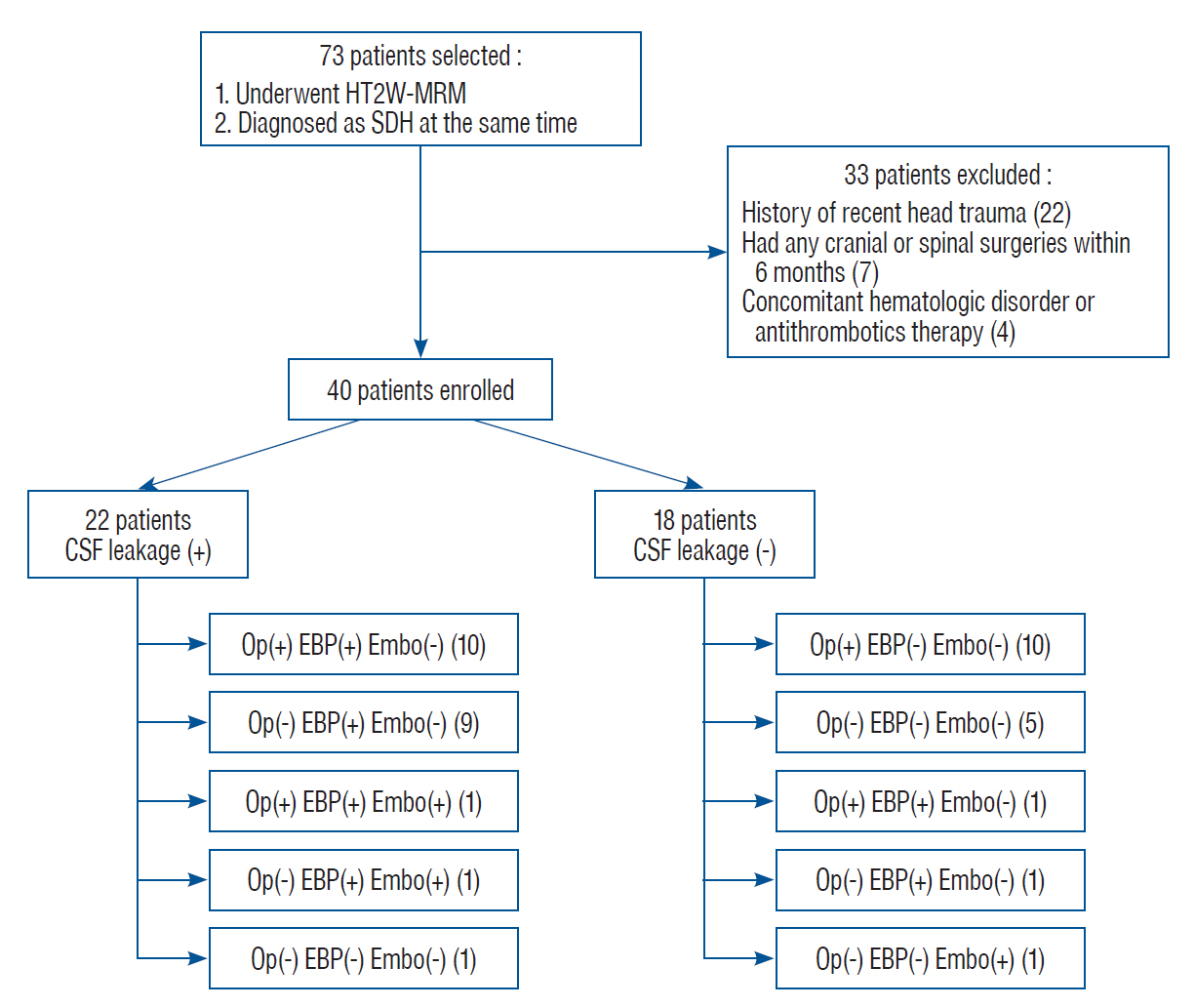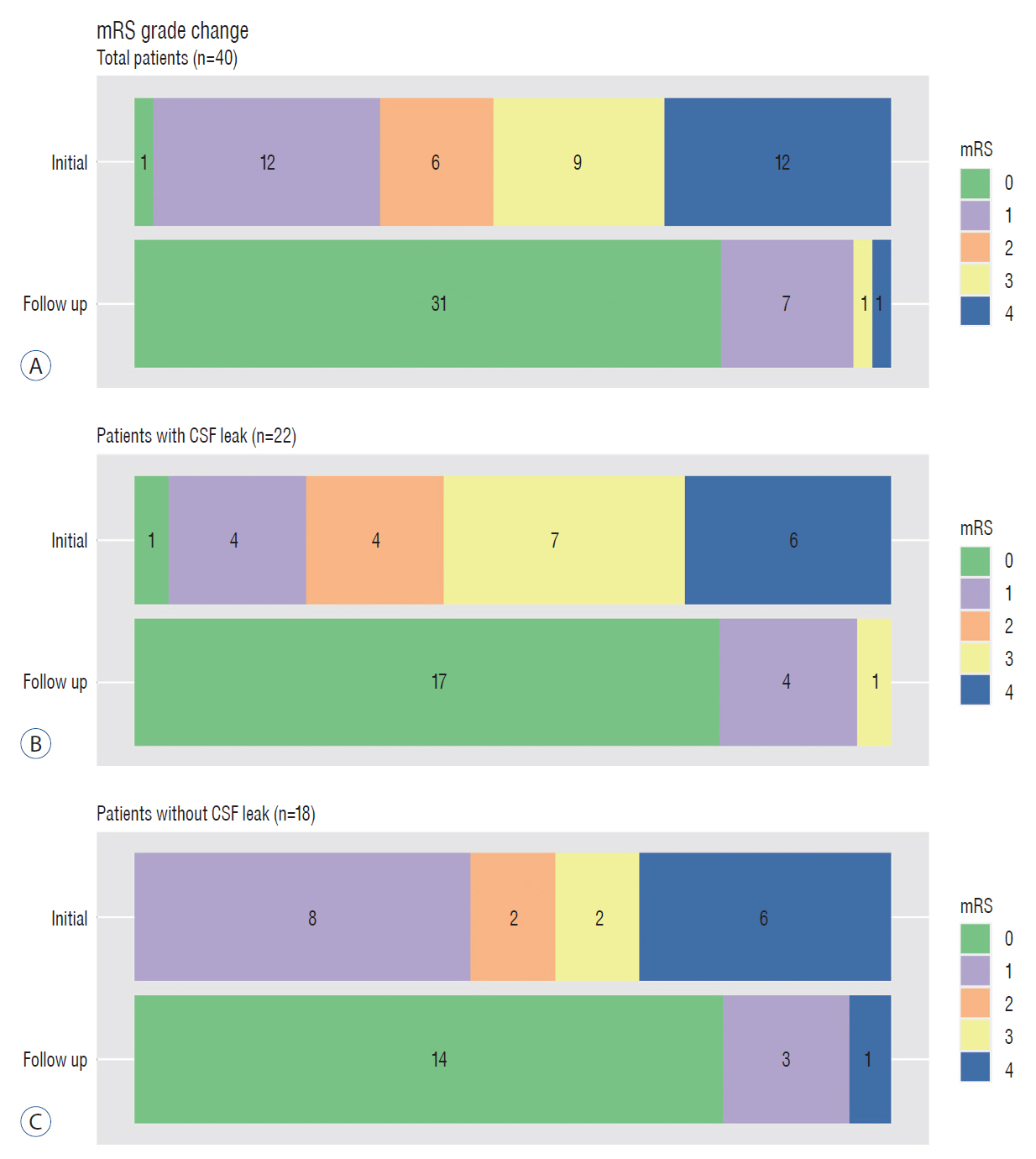J Korean Neurosurg Soc.
2022 Jan;65(1):13-21. 10.3340/jkns.2020.0326.
Heavily T2-Weighted Magnetic Resonance Myelography as a Safe Cerebrospinal Fluid Leakage Detection Modality for Nontraumatic Subdural Hematoma
- Affiliations
-
- 1Department of Neurosurgery, Seoul National University Bundang Hospital, Seoul National University College of Medicine, Seongnam, Korea
- 2Department of Neurology, Seoul National University Bundang Hospital, Seoul National University College of Medicine, Seongnam, Korea
- KMID: 2523909
- DOI: http://doi.org/10.3340/jkns.2020.0326
Abstract
Objective
: Nontraumatic subdural hematoma (SDH) is a common disease, and spinal cerebrospinal fluid (CSF) leakage is a possible etiology of unknown significance, which is commonly investigated by several invasive studies. This study demonstrates that heavily T2-weighted magnetic resonance myelography (HT2W-MRM) is a safe and clinically effective imaging modality for detecting CSF leakage in patients with nontraumatic SDH.
Methods
: All patients who underwent HT2W-MRM for nontraumatic SDH workup at our institution were searched and enrolled in this study. Several parameters were measured and analyzed, including patient demographic data, initial modified Rankin Scale (mRS) score upon presentation, SDH bilaterality, hematoma thickness upon presentation, CSF leakage sites, treatment modalities, followup hematoma thickness, and follow-up mRS score.
Results
: Forty patients were identified, of which 22 (55.0%) had CSF leakage at various spinal locations. Five patients (12.5%) showed no change in mRS score, whereas the remaining (87.5%) showed decreases in follow-up mRS scores. In terms of the overall hematoma thickness, four patients (10.0%) showed increased thickness, two (5.0%) showed no change, 32 (80.0%) showed decreased thickness, and two (5.0%) did not undergo follow-up imaging for hematoma thickness measurement.
Conclusion
: HT2W-MRM is not only safe but also clinically effective as a primary diagnostic imaging modality to investigate CSF leakage in patients with nontraumatic SDH. Moreover, this study suggests that CSF leakage is a common etiology for nontraumatic SDH, which warrants changes in the diagnosis and treatment strategies.
Keyword
Figure
Reference
-
References
1. Almenawer SA, Farrokhyar F, Hong C, Alhazzani W, Manoranjan B, Yarascavitch B, et al. Chronic subdural hematoma management: a systematic review and meta-analysis of 34,829 patients. Ann Surg. 259:449–457. 2014.2. Ban SP, Hwang G, Byoun HS, Kim T, Lee SU, Bang JS, et al. Middle meningeal artery embolization for chronic subdural hematoma. Radiology. 286:992–999. 2018.
Article3. Beck J, Gralla J, Fung C, Ulrich CT, Schucht P, Fichtner J, et al. Spinal cerebrospinal fluid leak as the cause of chronic subdural hematomas in nongeriatric patients. J Neurosurg. 121:1380–1387. 2014.
Article4. Beck J, Häni L, Ulrich CT, Fung C, Jesse CM, Piechowiak E, et al. : Diagnostic challenges and therapeutic possibilities in spontaneous intracranial hypotension. Clin Transl Neurosci 2 : 2514183X18787371, 2018. Beck J, Häni L, Ulrich CT, Fung C, Jesse CM, Piechowiak E, et al. Diagnostic challenges and therapeutic possibilities in spontaneous intracranial hypotension. Clin Transl Neurosci. 2:2514183X18787371. 2018.
Article5. Berroir S, Loisel B, Ducros A, Boukobza M, Tzourio C, Valade D, et al. Early epidural blood patch in spontaneous intracranial hypotension. Neurology. 63:1950–1951. 2004.
Article6. Busl KM, Prabhakaran S. Predictors of mortality in nontraumatic subdural hematoma. J Neurosurg. 119:1296–1301. 2013.
Article7. Chen HH, Huang CI, Hseu SS, Lirng JF. Bilateral subdural hematomas caused by spontaneous intracranial hypotension. J Chin Med Assoc. 71:147–151. 2008.
Article8. Chen YC, Wang YF, Li JY, Chen SP, Lirng JF, Hseu SS, et al. Treatment and prognosis of subdural hematoma in patients with spontaneous intracranial hypotension. Cephalalgia. 36:225–231. 2016.
Article9. Chung SJ, Lee JH, Kim SJ, Kwun BD, Lee MC. Subdural hematoma in spontaneous CSF hypovolemia. Neurology. 67:1088–1089. 2006.
Article10. Dehaene S, Biesemans J, Van Boxem K, Vidts W, Sterken J, Van Zundert J. Post-dural puncture headache evolving to a subdural hematoma: a case report. Pain Pract. 21:83–87. 2021.
Article11. Dhillon AK, Rabinstein AA, Wijdicks EF. Coma from worsening spontaneous intracranial hypotension after subdural hematoma evacuation. Neurocrit Care. 12:390–394. 2010.
Article12. Ferrante E, Arpino I, Citterio A, Savino A. Coma resulting from spontaneous intracranial hypotension treated with the epidural blood patch in the trendelenburg position pre-medicated with acetazolamide. Clin Neurol Neurosurg. 111:699–702. 2009.
Article13. Ferrante E, Olgiati E, Sangalli V, Rubino F. Early pain relief from orthostatic headache and hearing changes in spontaneous intracranial hypotension after epidural blood patch. Acta Neurol Belg. 116:503–508. 2016.
Article14. Ferrante E, Trimboli M, Pontrelli G, Rubino F. Early coma awakening after epidural blood patch. J Clin Neurosci. 71:295–296. 2020.
Article15. Frontera JA, Egorova N, Moskowitz AJ. National trend in prevalence, cost, and discharge disposition after subdural hematoma from 1998-2007. Crit Care Med. 39:1619–1625. 2011.
Article16. Gordon N. Spontaneous intracranial hypotension. Dev Med Child Neurol. 51:932–935. 2009.
Article17. Hashizume K, Watanabe K, Kawaguchi M, Fujiwara A, Furuya H. Evaluation on a clinical course of subdural hematoma in patients undergoing epidural blood patch for spontaneous cerebrospinal fluid leak. Clin Neurol Neurosurg. 115:1403–1406. 2013.
Article18. Kim BR, Lee JW, Lee E, Kang Y, Ahn JM, Kang HS. Utility of heavily T2-weighted MR myelography as the first step in CSF leak detection and the planning of epidural blood patches. J Clin Neurosci. 77:110–115. 2020.
Article19. Kim J, Moon J, Kim T, Ahn S, Hwang G, Bang J, et al. Risk factor analysis for the recurrence of chronic subdural hematoma: a review of 368 consecutive surgical cases. Korean J Neurotrauma. 11:63–69. 2015.
Article20. Klein KM, Shiratori K, Knake S, Hamer HM, Fritsch B, Todorova-Rudolph A, et al. Status epilepticus and seizures induced by iopamidol myelography. Seizure. 13:196–199. 2004.
Article21. Louhab N, Adali N, Laghmari M, Hymer WE, Ben Ali SA, Kissani N. Misdiagnosed spontaneous intracranial hypotension complicated by subdural hematoma following lumbar puncture. Int J Gen Med. 7:71–73. 2014.
Article22. Mao YT, Dong Q, Fu JH. Delayed subdural hematoma and cerebral venous thrombosis in a patient with spontaneous intracranial hypotension. Neurol Sci. 32:981–983. 2011.
Article23. Perez-Vega C, Robles-Lomelin P, Robles-Lomelin I, Diaz-Alba A, Navarro VG. Acute subdural hematoma recurrence during drain removal associated with spontaneous intracranial hypotension - a non-reported complication. Surg Neurol Int. 11:316. 2020.
Article24. Sayer FT, Bodelsson M, Larsson EM, Romner B. Spontaneous intracranial hypotension resulting in coma: case report. Neurosurgery. 59:E204. discussion E204. 2006.
Article25. Schievink WI. Stroke and death due to spontaneous intracranial hypotension. Neurocrit Care. 18:248–251. 2013.
Article26. Schievink WI, Maya MM, Moser F, Tourje J, Torbati S. Frequency of spontaneous intracranial hypotension in the emergency department. J Headache Pain. 8:325–328. 2007.
Article27. Schievink WI, Maya MM, Moser FG, Tourje J. Spectrum of subdural fluid collections in spontaneous intracranial hypotension. J Neurosurg. 103:608–613. 2005.
Article28. Schievink WI, Maya MM, Pikul BK, Louy C. Spontaneous spinal cerebrospinal fluid leaks as the cause of subdural hematomas in elderly patients on anticoagulation. J Neurosurg. 112:295–299. 2010.
Article29. Souirti Z, Benzagmout M, Belahsen F, Chaoui ME. Spontaneous bilateral subacute subdural hematoma revealing intracranial hypotension. Neurosciences (Riyadh). 14:384–385. 2009.30. Takahashi K, Mima T, Akiba Y. Chronic subdural hematoma associated with spontaneous intracranial hypotension: therapeutic strategies and outcomes of 55 cases. Neurol Med Chir (Tokyo). 56:69–76. 2016.
Article31. Tsai PH, Fuh JL, Lirng JF, Wang SJ. Heavily T2-weighted MR myelography in patients with spontaneous intracranial hypotension: a case-control study. Cephalalgia. 27:929–934. 2007.
Article32. Tsai PH, Fuh JL, Lirng JF, Wang SJ. Comparisons between heavily T2-weighted MR and CT myelography studies in two patients with spontaneous intracranial hypotension. Cephalalgia. 28:653–657. 2008.
Article33. Wang YF, Lirng JF, Fuh JL, Hseu SS, Wang SJ. Heavily T2-weighted MR myelography vs CT myelography in spontaneous intracranial hypotension. Neurology. 73:1892–1898. 2009.
Article34. Whiteley W, Al-Shahi R, Myles L, Lueck CJ. Spontaneous intracranial hypotension causing confusion and coma: a headache for the neurologist and the neurosurgeon. Br J Neurosurg. 17:456–458. 2003.
Article35. Yadav YR, Parihar V, Namdev H, Bajaj J. Chronic subdural hematoma. Asian J Neurosurg. 11:330–342. 2016.
Article36. Yoon SH, Chung YS, Yoon BW, Kim JE, Paek SH, Kim DG. Clinical experiences with spontaneous intracranial hypotension: a proposal of a diagnostic approach and treatment. Clin Neurol Neurosurg. 113:373–379. 2011.
Article
- Full Text Links
- Actions
-
Cited
- CITED
-
- Close
- Share
- Similar articles
-
- Detection of Surgery-related Spinal Cerebrospinal Fluid Leakage Using Magnetic Resonance Myelography
- A Case of Cerebrospinal Fluid Hypovolemic Syndrome with Impairment of the Level of Consciousness
- Chronic Subdural Hematoma after Spontaneous Intracranial Hypotension : A Case Treated with Epidural Blood Patch on C1-2
- Two Cases of Secondary Intracranial Hypotension
- A Case of Aggravated Chronic Subdural Hematoma after Cervical Myelography



